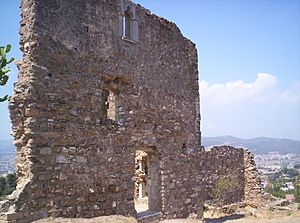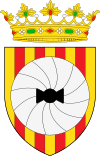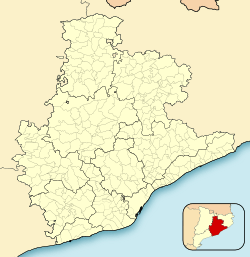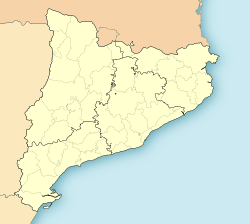Molins de Rei facts for kids
Quick facts for kids
Molins de Rei
Molins de Rey
|
||
|---|---|---|

Castellciuró Castle.
|
||
|
||
| Country | ||
| Community | ||
| Province | Barcelona | |
| Comarca | Baix Llobregat | |
| Area | ||
| • Total | 15.9 km2 (6.1 sq mi) | |
| Elevation | 37 m (121 ft) | |
| Population
(2018)
|
||
| • Total | 25,687 | |
| • Density | 1,616/km2 (4,184/sq mi) | |
| Demonym(s) | Molinenc | |
Molins de Rei (which means "King's Mills") is a town in Catalonia, Spain. It's about 18 kilometers (11 miles) from the center of Barcelona. The town is part of the Baix Llobregat area.
Molins de Rei is located on the left side of the Llobregat river. It's also near major roads like the A-7 autopista (motorway) and the N-II road. Because of its great location, Molins de Rei has become an important place for businesses and industries.
Contents
History of Molins de Rei
How Molins de Rei Got Its Name
The name Molins de Rei means "King's Mills." This comes from the royal windmills that were built here a very long time ago. We know about these mills from records dating back to 1188.
King Alfonso II of Aragon ordered these mills to be built. Their construction was a big step in creating the town. By 1208, Molins de Rei already had a church, a parish, and a cemetery.
Changing Owners and New Buildings
In 1309, the town was part of the Pallars county, owned by Countess Sibil·la. After she passed away, Molins de Rei changed hands many times. It went to Hugo de Arborea and then to a convent in Sardinia, Italy.
Later, in 1366, Berenguer de Relat bought the land. In 1430, it was transferred again to Galceran de Requesens i de Santacoloma. He built a grand palace in the village. Famous people like the Catholic Monarchs and Christopher Columbus even visited this palace!
The Bridge and Wars
In 1763, a bridge was built over the Llobregat river. King Charles III of Spain ordered its construction. This bridge made Molins de Rei a very important spot during the Peninsular War.
Because of its strategic location, the town suffered many attacks and fires. Sadly, several important buildings, including the beautiful Palace of Requesens, were destroyed during these conflicts.
Main Sights to See
Molins de Rei has some interesting historical places to visit.
Palace of Recasens Ruins
The Palace of Recasens was built in the 15th century. It was damaged and looted during the 19th century, so today only its ruins remain.
Castellciuró Castle
Outside the town, you can find the ruins of Castellciuró castle. This castle was built in 1066. It might have even been built on top of an older Visigoth fort. The castle was destroyed in 985 by troops led by al-Mansur Ibn Abi Aamir. You can still see parts of its walls and a tower.
Sant Pere de Romaní Chapel
The Romanesque chapel of Sant Pere de Romaní is known from 1011. It has a rectangular shape and a special barrel vaulted ceiling. There is also a bell tower.
Getting Around Molins de Rei
Molins de Rei is well-connected, making it easy to travel to and from the town.
Train Services
The Molins de Rei train station is served by RENFE railway lines R1 and R4. These trains run often to and from central Barcelona. A trip to Plaça Catalunya in Barcelona takes about 25 minutes.
Bus and Taxi Services
Local buses also connect the town to central Barcelona. Since Molins de Rei is part of the Barcelona Metropolitan Area, you can find the famous yellow taxis. They are usually found in the square where Avinguda de Barcelona and Avinguda de València meet.
Road Connections
The C-1413 road also connects Molins de Rei to Sabadell.
Famous People from Molins de Rei
Many notable people have come from Molins de Rei:
- Agustí Roc Amador (born 1971), a ski mountaineer and long-distance runner.
- Guillem Ballaz (born 1978), a Catalan musician.
- Jordi Hurtado (1957–Present), a well-known radio and television presenter and voice actor.
- Miquel Carbonell Selva (1854–1896), a painter known for portraits and landscapes.
- Margarita Xirgu (1888–1969), an international actress.
- Luis de Requesens y Zúñiga, a Spanish diplomat and politician from the 16th century.
Sister Cities
Molins de Rei has "sister city" relationships with two other towns:
 Lorca, Spain
Lorca, Spain Chinandega, Nicaragua
Chinandega, Nicaragua
See also
 In Spanish: Molins de Rey para niños
In Spanish: Molins de Rey para niños





